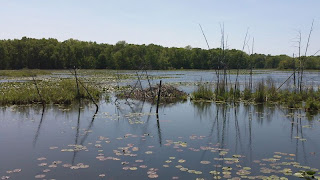 |
| Beaver dam in Canada's Wood Buffalo National Park spanning 2,800 feet. Several generations have been working on the dam since the 1970's. Average size of a dam is 10 to 100 meters. |
The main reason beavers build dams is to act as a "lodge." Here they find protection from predators and the heavy currents of the river where they often live. Since they do not hibernate, dams also provide a place to store food for the winter. When snow falls in the winter, the layer of snow acts as in igloo does, keeping the dam warm and preventing their stored food from freezing. They also build dams to function has a canal, slowing the water current in order to ease the transport of trees and sticks to their "lodge" dam.
 |
| A small beaver dam in a lake in Michigan. |
One of the most interesting aspects of beaver dams are how and why they build them. Studies have shown a great array of dam building techniques, each suited to the body of water they are built in. Despite the reasons stated above as to why they build dams, studies have also shown the sound of the current may be what triggers their dam building. Beavers that have been known to build dams in the past have been relocated to areas without a current, and instead of building a dam, settled instead on digging a burrow for protection.
Many view beaver dams has a destructive, mainly when an entire dam will burst and give away, often destroying roads, farms, railroads, etc. Beavers are also known to destroy large areas of forest, but we really have no place to talk when looking at the amount of forest destruction humans are responsible for. Despite these negatives, there are even more positives.
Dams are a huge aspect in restoring wetlands by reducing erosion, breaking down toxins, and increasing biodiversity by supplying homes to many species. Some birds even lay their nests within dams! They also provide a great home for young salmon and frog larvae by supplying a slow, warm current where they are protected from many predators. Studies have shown that in areas where beavers and dams had been removed, the salmon population declined dramatically.
Fun Beaver Facts:
- Beavers can transport their own weight in material.
- It takes 20 minutes for a beaver to cut down a 6 inch wide trees.
- When their tree is falling, they run away frantically.
- Beavers usually build their dams at night.
- When a dam breaks, they rush around frantically to fix it.
- A dam being studied was destroyed by reckless humans and it only took two days for the beavers to rebuild.

No comments:
Post a Comment